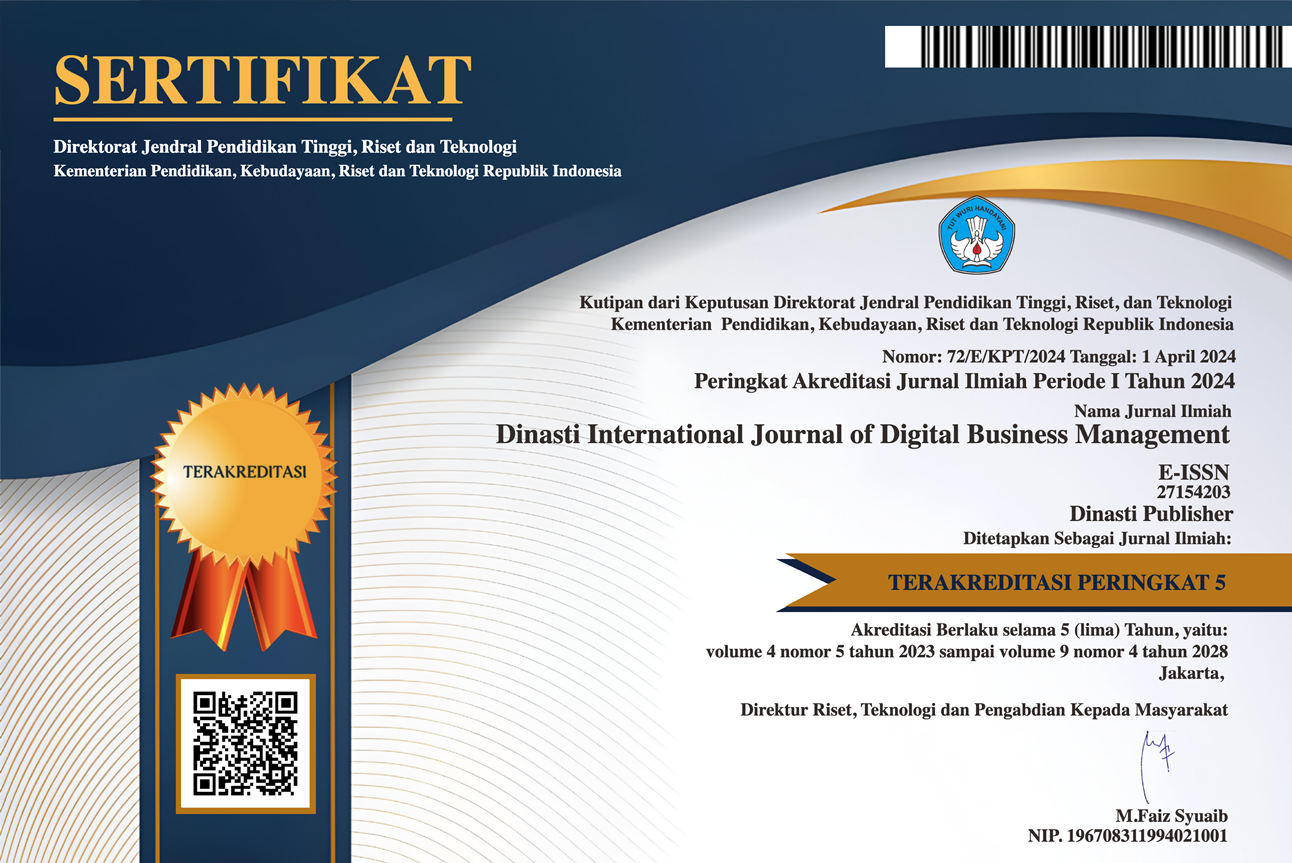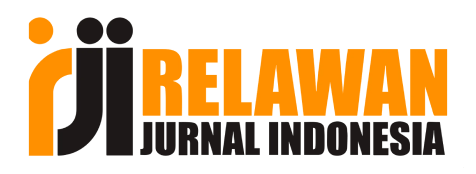K-Means Clustering Segmentation Based on Consumer Interest Using SPSS Program at XYZ Indonesia Customers
DOI:
https://doi.org/10.38035/dijdbm.v6i3.4563Keywords:
Customer segmentation, K-Means Clustering, consumer behavior, digital marketing, marketing strategy, SPSS, PT XYZ Indonesia, food and beverage industry, social media promotion, customer loyaltyAbstract
This study aims to understand the preferences and behavior of PT XYZ Indonesia's customers through K-Means Clustering segmentation analysis using the SPSS program. PT XYZ Indonesia, a restaurant that combines Japanese and Indonesian cuisine, has adopted various digital marketing strategies to enhance their online brand presence and strengthen customer relationships. In this study, data was collected through questionnaires filled out by 102 respondents who are customers of PT XYZ Indonesia. The data includes demographic variables such as gender, age, marital status, occupation, monthly income, as well as consumer behavior variables such as ordering platforms, information sources, visit frequency, restaurant location distance, and menu preferences. Through K-Means Clustering analysis, customers were grouped into six different clusters based on their interests and behavior. One prominent cluster is Cluster 3, which consists of young customers who are active on social media and frequently order food through online platforms such as Shopee Food. This cluster has key characteristics such as being male, 27 years old, single, working as private employees with a monthly income between 5 to 10 million rupiah, and having a specific preference for the Enog Berger Mayo menu. This study provides significant business implications for PT XYZ Indonesia, including increasing promotional activities on social media, offering exclusive discounts through online platforms, optimizing restaurant locations, developing menus that are favored by customers, and improving delivery services. By implementing the right strategies based on these segmentation results, PT XYZ Indonesia can enhance customer satisfaction, strengthen loyalty, and improve their market position. This study also emphasizes the importance of using segmentation techniques to understand consumer preferences and behavior in directing more effective and efficient marketing strategies.
References
Aggelis, V., & Christodoulakis. (2005). Customer Clustering using RFM Analysis. In Proceedings of the 9th WSEAS International Conference on Computers (ICCOMP '05).
Angelie, A. V. (2017). Segmentasi Pelanggan Menggunakan Clustering K-Means dan Model RFM (Studi Kasus: PT. Bina Adidaya Surabaya). Institut Teknologi Sepuluh Nopember Surabaya.
Bahar, A., Pramono, B., & Sagala, L. H. S. (2016). Penentuan strategi penjualan alat-alat tattoo di studio sonyxtattoo menggunakan metode. SemanTIK, 2(2), 75-86.
Bhatia, S. K. (2012). A Propound Method For The Improvement of Cluster Quality. IJCSI International Journal of Computer Science Issues. 9(4), 216-221.
Bholowalia, P., & Kumar, A. (2014). EBK-Means: A Clustering Technique based on Elbow Method and K-Means in WSN. International Journal of Computer Application, 105(9), 17-24.
Brock, G., Pihur, V., Datta, S., & Datta, S. (2011). clValid, an R package for cluster validation. Journal of Statistical Software.
Cali?ski, T., & Harabasz, J. (1974). A dendrite method for cluster analysis. Communications in Statistics - Theory and Methods, 3, 1-27.
Cheng, C.-H., & Chen, Y.-S. (2009). Classifying the segmentation of customer value via RFM model and RS Theory. Expert Systems with Applications, 36, 4176-4184.
Gaffar, V. (2007). CRM dan MPR Hotel. Bandung: Alfabeta.
Han, J., & Kamber, M. (2006). Data Mining: Concept and Techniques (2nd ed.). Morgan Kaufmann Publishers.
Herlinda, V., Darwis, D., & Dartono. (2021). Analisis Clustering Untuk Redesialing Fasilitas Kesehatan Menggunakan Metode Fuzzy C-Means. Jurnal Teknologi Dan Sistem Informasi (JTSI), 2(2), 94-99.
Hughes, A. M. (1994). Strategic Database Marketing. Chicago: Probus Publishing.
Junaedi, H., Budianto, H., Maryati, I., & Melani, Y. (2011). Data Transformation Pada Data Mining. In Prosiding Konferensi Nasional “Inovasi dalam Desain dan Teknologi”. (93-99).
Kamila, I., Khairunnisa, U., & Mustakim. (2019). Perbandingan Algoritma K-Means dan K-Medoids untuk Pengelompokan Data Transaksi Bongkar Muat di Provinsi Riau. Jurnal Ilmiah Rekayasa dan Manajemen Sistem Informasi, 5(1), 119-125.
Khajvand, M., & Tarokh, M. J. (2011). Estimating Customer Future Value of Different Customer Segments Based on Adapted RFM Model in Retail Banking Context. Procedia Computer Science, 3, 1327-1332.
Kodinariya, T. M., & Makwana, D. P. R. (2013, November). Review penentuan jumlah Cluster di Pengelompokan K-Means. Jurnal Internasional Penelitian Lanjutan di Ilmu Komputer dan Studi Manajemen, 1(6), 90-95. : https://www.researchgate.net/publication/313554124
Kotler, P., & Keller, K. (2007). Manajemen Pemasaran (Jilid I, Edisi Kedua belas). Jakarta: PT. Indeks.
Kusrini, & Luthfi, E. T. (2009). Algoritma Data Mining. Yogyakarta: Andi.
Larose, D. T. (2005). Discovering Knowledge In Data: An Introduction To Data Mining. John Wiley & Sons, Inc.
Lestarini, A. H. (2017). 2020, Industri Kecantikan RI Siap Libas Asia Tenggara. Metrotvnews. Retrieved from http://ekonomi.metrotvnews.com/mikro/8N0eqoEb-2020-industri-kecantikan-ri-siap-libas-asia-tenggara
Luthfi, M. A., & Nilogiri, A. (2019). Implementasi Algoritma K-Means Clustering Untuk Pengelompokan Minat Konsumen Pada Produk Online Shop. Universitas Muhammadiyah Jember, 1-5.
Mulyati, S. (2015). Penerapan Data Mining dengan Metode Clustering untuk Pengelompokan Data Pengiriman Burung. Seminar Ilmiah Nasional Teknologi Komputer, 30-35.
Mulyono, R., Ndini, A. S., Kharisma, G., & Heikal, J. (2023). Segmentation K-Means Clustering Model With SPSS Program Case Study Customer The Park Mall Sawangan. Syntax Literate:Jurnal Ilmiah Indonesia, 8(2). http://dx.doi.org/10.36418/syntax-literate.v8i2.11429
Nasari, F., & Darma, S. (2015). Penerapan K-Means Clustering pada Data Penerimaan Mahasiswa Baru (Studi Kasus: Universitas Potensi Utama). Seminar Teknologi Informasi dan Multi Media 2015 (pp. 73-78). Yogyakarta: STMIK AMIKOM.
Nasution, S. A., Poningsih, & Okprana, H. (2021). Penerapan Algoritma K-Means Pada Penjualan Frozen Food Pada UD Soise Sosis Pematangsiantar. Jurnal Sistem Komputer dan Informatika (JSON), 2(2), 171-177.
Normah, N., Rifai, B., & Sari, P. (2020). Algoritma Apriori Sebagai Solusi Kontrol Persediaan Suku Cadang Mobil PT. Buanasakti Aneka Motor Jakarta. Paradigma - Jurnal Komputer Dan Informatika, 22(2), 161-168. https://doi.org/10.31294/p.v22i2.6530
Nurajizah, S. (2019). Analisa Transaksi Penjualan Obat menggunakan Algoritma Apriori. INOVTEK, 4(1), 35-44.
Piatetsky, G., & Shapiro. (2006). An Introduction Machine Learning, data mining, and Knowledge discovery, Course in data mining Kdnuggets.
Piatetsky, G., & Shapiro. (2006). An Introduction to Machine Learning, Data Mining, and Knowledge Discovery. Kdnuggets.
Rainer, R. K., & Cegielski, C. G. (2011). Introduction to Information Systems (3rd ed.). USA: Wiley.
Rohmawati, N., Defiyanti, S., & Jajuli, M. (2015). Implementasi Algoritma K-MEANS dalam Pengklasteran Mahasiswa Pelamar Beasiswa. Jurnal Ilmiah Teknologi Informasi Terapan, 1(2), 62-67.
Sauro, J. (2011). Measuring Usability With The System Usability Scale (SUS). Retrieved from http://www.measuringu.com/sus.php.
Sauro, J. (2013). A Single-Item Measure of Website Usability: Comments on Christophersen and Konradt (2011). Interacting with Computers. 25(4), 302-303.
Silahi, M. (2018). Analisis Clustering Menggunakan Algoritma K-Means Terhadap Penjualan Produk Pada Batamas Niaga Jaya. Computer Based Information System Journal, 6(2), 20-34.
Tan, P.-N., Steinbach, M., & Kumar, V. (2005). Introduction to Data Mining. Boston: Addison-Wesley Longman Publishing Co.
Tsiptsis, K., & Chorianopoulos, A. (2009). Data Mining Techniques in CRM: Inside Customer Segmentation. Chichester, West Sussex, U.K: Wiley.
Downloads
Published
Issue
Section
License
Copyright (c) 2025 Pontjo Utomo, Mia Tampi, Diny Claudia, Jerry Haikal

This work is licensed under a Creative Commons Attribution 4.0 International License.
Authors who publish their manuscripts in this journal agree to the following conditions:
- The copyright on each article belongs to the author(s).
- The author acknowledges that the Dinasti International Journal of Digital Business Management (DIJDBM) has the right to be the first to publish with a Creative Commons Attribution 4.0 International license (Attribution 4.0 International (CC BY 4.0).
- Authors can submit articles separately, arrange for the non-exclusive distribution of manuscripts that have been published in this journal into other versions (e.g., sent to the author's institutional repository, publication into books, etc.), by acknowledging that the manuscript has been published for the first time in the Dinasti International Journal of Digital Business Management (DIJDBM).















































